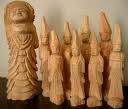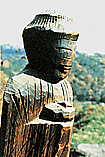. Welcome to Master Carver Enku 円空 ! .
:::::::::::::::::::::::::::::::::::::::::::::::::::::::::::::::::::::::::::::::::::::::::::::::::::::
Buddhist Sculptors Gallery
:::::::::::::::::::::::::::::::::::::::::::::::::::::::::::::::::::::::::::::::::::::::::::::::::::::
Enku, the Master Carver 円空 (Enkuu)
[1632?~1695]

This book by my friend and fellow kyudo archer Dotzenko covers all the aspects of Enku's art. Grisha lived in Kamakura while we were there too, introducing me to Enku, Mokujiki and a lot more of Buddhist Art. I owe a lot to this wonderful person.
"ENKU, MASTER CARVER",
by Dotzenko. Grisha, F.,
Kodansha International Ltd. Toyko, 1976. Fine, Fine. First Edition as stated. Incl. Forward by Tsuneyoshi Tsuchiya. Monograph of the itinerant Buddhist priest who roamed remote villages in Japan leaving thousands of his inimitable "hatchet-carved" statues.
11 9 plates. 156 pages.
:::::::::::::::::::::::::::::::::::::::::::::::::::::::::::::::::::::::::::::::::::::::::::::::::::::::::::::::::::::::::::::::::
Enku has now its own BLOG - January 2013 :
. Welcome to Master Carver Enku 円空 ! .
:::::::::::::::::::::::::::::::::::::::::::::::::::::::::::::::::::::::::::::::::::::::::::::::::::::::::::::::::::::::::::::::::
Look at more Fudo Myo-O by Enku
. Enku and his Fudo Statues 円空仏
:::::::::::::::::::::::::::::::::::::::::::::::::::::::::::::::::::::::::::::::::::::::::::::::::::::
How a piece of wood becomes a Buddha Statue
in the hands of Enku
In the forest

a vision

taking shape

from Honda, infoseek
.............................................................................
Enku walked all along Japan and attended mostly to the poor people. If he could not help the dying in a village any more, he would take a piece of firewood from a man's hut, cut a rough figure of Kannon Bosatsu and give it to the poor, telling him or her to use it as a guide on the trip to the nether world.
He also cut rough koppa butsu 木っ端仏, statues from scrap, to console poor mothers who had lost their babies, either through accidents or on purpose, since they could not feed and raise female babies in many regions of Northern Japan. (By the way, many Kokeshi (1) こけし were carved for that purpose too.)
.. .. .. .. .. Koppa-Butsu Statues こっぱぶつ

On the Tsugaru penninsula, there are many temples who still house one or two Enku Statues. In one temple I visited, we could not see it, because, as the priest told me, the statue was all eaten by mice. Well, how come the mice eat wood? I asked him. Poor people throw a handful of rice over the statues after the harvest as an offering and thank , and the Enku statues have many nooks where the rice is left. In winter, the mice come feeding on these offerings, picking bit by bit off the wood too.
In Memory of his death 130 years ago, now in 2005 there is a special
Enku Exhibition in Kobe at the Daimaru Department store.
March 9 to 21.
円空展 大丸ミュージアムKOBE

http://www.fururu.net/category/monthly/1106140859
.................................................................................

Self-Portrait of Enku in Seki, Gifu 自刻像
善財童子 (通称 自刻像)神明神社 所蔵
http://www.city.seki.gifu.jp/kankou/seki/enku.html
:::::::::::::::::::::::::::::::::::::::::::::::::::::::::::::::::::::::::::::::::::::::::::
うぐひすに耳欹てん円空仏
uguisu ni mimi sobadaten Enkuu butsu
he pricks his ear
to listen to the uguisu -
this Enku statue
Shintani Hiroshi 新谷ひろし
. Amulets for Ear Diseases .
Born in Gifu Prefecture, Enku the Priest traveled on foot throughout Japan and carved approximately 120,000 wooden images of Buddha during his lifetime. He is said to have had no permanent home, however, during his latter years, he rooted himself deeply into the town of Seki. After the restoration of the Mirokuji Temple, he entered a stationary life to attain Buddhahood during his lifetime on the banks of the Sagami River in Seki.

Today, there remain over 150 images of "Enku Buddha" 円空仏 carved by Enku the Priest. "Enku Buddha", a simple wooden statue dynamically carved with a single hatchet, may appear unrefined, however, the faces of Buddha express affluent emotions. His unique style has also attracted fans from overseas, enjoying high appraisal.
Enku went on a pilgrimage all over Japan, and carved Buddhist statues one after another. More than 150 statues by Enku have been identified and authenticated in Seki City, and it has been said that he entered nirvana in this area. A memorial stela for his entrance to nirvana now stands there, silently looking at the Nagara River.
The Enku House
The Enku House is a resource center featuring Enku the Priest who is strongly associated with Seki City. Built to be the main attraction for the historical park plan, here you will find displays of his carved Buddha images and an introduction of his entering into the life of Buddhahood.It is the core facility for the Field Museum, interlocking the Mirokuji Temple, where Enku spent his latter years, and the Sagara River, where he attained Buddhahood. Many of the images of Buddha carved by Enku, which are found within the city, are displayed here.
http://www.sekikanko.jp/e/guide/enku.html

Enku's Grave ath the temple Miroku Ji 弥勒寺
http://www.nihonkoenmura.jp/theme3/enku04.htm
Enku made 120,000 wooden images of Buddha during his life-long pilgrimage on which he visited many parts of Japan, including Hokkaido. It is said that he reached Seki and died here. Though he led his life as a poor pilgrim and traveling artist, he is said to have been an almsgiver all his life. When we look at his wooden statue of himself, we can feel his warm personality. 入定塚 Nyujo-tsuka is Enku's grave. It is said that in 1688 he was buried here.
Buddhist prayers were the passion that drove him to a lifelong commitment to art and recited many while many villagers watched in sorrow. Mirokuji Temple Ruin is the remains of a temple reconstructed by Enku in his later years. We can still see the remains of a tower built in the Hakuho period.
http://www.nhk-chubu-brains.co.jp/DDT-E/gifu/seki/enku.html
:::::::::::::::::::::::::::::::::::::::::::::::::::::::::::::::::::::::::::::::::::::::::::
ENKU: YAKUSHI SANZON 薬師三尊
(Triad Image of Yakushi Buddha by Enku)

http://www.forest.minokamo.gifu.jp/ART/bunkazai/b3.html
These images were created by Reverend Enku when he visited the Shima region in 1674.Two Bodhisattva figures (Nikko and Gakko) are placed on both sides of the Yakushi Buddha, representing the center of bliss. They all look as though they are watching the present world clad with garments woven from the passage of time.
http://www.town.isobe.mie.jp/cont_en/history/5/indexc.html
:::::::::::::::::::::::::::::::::::::::::::::::::::::::::::::::::::::::::::::::::::::::::::
Enku, unlike traditional sculptors, sculptured freely, roughly, and unexpectedly by using one piece of scrap wood and timber sent afloat down a river. Koppabutsu 木っ端仏 are made from scrap pieces of wood.
He was an extraordinary novelist in the early Edo era who expressed his strong religious believe in carving.
Images of 12 Heavenly Generals 十二神将

Saitama Prefecture
Another link with Enku Material, in Japanese.
Small Kannon Statues 観音群像
. . . CLICK here for Photos !
Yakushi Nyorai 薬師如来
. . . CLICK here for Photos !
Owarino Enku Butsu 尾張野の円空仏
. . . CLICK here for Photos !
Enku Statues of Hokkaido 北海道の円空仏
http://www.hiyama.or.jp/enku/
.. .. .. .. .. .. .. .. .. .. .. .. .. .. Click on the map
http://www.hiyama.or.jp/enku/butuzo/default.htm
http://www.hiyama.or.jp/enku/butuzo/20.htm
http://www.hiyama.or.jp/enku/butuzo/03.htm
:::::::::::::::::::::::::::::::::::::::::::::::::::::::::::::::::::::::::::::::::::::::::::
Enku was born in Hashima, Gifu Prefecture.
There is now a small Museum with 17 statues in his honour.
There is also a Kannon Statue in memorial of his mother, who drowned in a flood in 1638.
円空上人生誕の地「はしま」で最も多くの円空仏が安置されている中観音堂・羽島円空資料館では、本尊の十一面観音像をはじめ17体の円空仏(県重要文化財)を間近に見ることができます。
. . . CLICK here for Photos !
:::::::::::::::::::::::::::::::::::::::::::::::::::::::::::::::::::::::::::::::::::::::::::
Enku Museum at Senkoo-Ji Temple 円空仏寺宝館

The above picture shows Ryoomen Sukuna, a famous deity with two faces. Usually this deity holds bow and arrow, but thinking of the woodworking people of Hida, Enku depicted him with an ax instead.
千光寺を開山したともいわれる両面宿儺は、日本書紀によると、「体は一つであるが、顔が前後にあり手足が4本ずつある力持ちであった。4本の手で弓矢や剣を同時に用いて、皇命に隨わなかったため征伐された」という意味のことが記されているようである。しかし飛騨人にとっては飛騨の国を統治していた豪族であったとして、なじみ深い存在となっている。円空は、これの造型化に当たり独特の感覚と創造性をもって、後ろにあったという顔や手を前に並べ、持っている弓矢を斧にかえた。顔の表情も善悪両面を表している。善を中心にしているところから、飛騨人の立場になって造ったのではないかと想像される。円空の晩年作で屈指の傑作とされている。
http://www6.plala.or.jp/ebisunosato/enku.htm
. Ryoomen Sukuna 両面宿儺 Sukuna with two faces .
:::::::::::::::::::::::::::::::::::::::::::::::::::::::::::::::::::::::::::::::::::::::::::
Enku Museum in Minami Town, Gifu Pref.
About 90 Statues of Enku.
円空のふるさとと言われる美並町に最もふさわしいのが、この美並ふるさと館でしょう。円空ふるさと館と生活資料館に分かれ、円空ふるさと館には初期から晩年期にかけて彫られた円空仏約90体を展示しているほか、円空上人の生涯を写真やパネルでたどれるようになっています。
http://minami-kanko.appa-net.com/minami06_3.html
More Links with Enku Statues
Arako Kannon 荒子観音寺の円空仏
. 荒子観音 Arako Kannon - Nagoya .

. . . CLICK here for Photos : Arako Kannon!
Yakushi Temple in Nagoya 鉈薬師の円空仏

http://www.a-namo.com/ku_info/chikisaku/pages_n/enku_butsu.htm
Miroku Temple and Enku Buddhas
美濃・関・弥勒寺

:::::::::::::::::::::::::::::::::::::::::::::::::::::::::::::::::::::::::::::::::::::::::::
円空は、江戸時代前期に北海道から近畿に至る各地を旅したお坊さんです。各地に多数の「円空仏」と呼ばれる粗削りの木彫仏像を刻み、残していきました。飛騨地方でも各地の寺社や旧家に多くの円空仏が見られます。

「ナタバツリ」と呼ばれる鉈で粗く削った独特の製作スタイルや、粗削りながらもどことなく柔和で温かみがある表情は多くの人を魅了しつづけています。飛騨の里にあるものは、円空の作風に魅せられた近年の職人たちによる作品です。
http://www.hidanosato.org/shinko/rbsb_main.html
:::::::::::::::::::::::::::::::::::::::::::::::::::::::::::::::::::::::::::::::::::::::::::::::::::::
Some safekeep copys of the Fudo Pictures are here, starting from #49.
My Photo Album : Fudo Myo-O
:::::::::::::::::::::::::::::::::::::::::::::::::::::::::::::::::::::::::::::::::::::::::::::::::::::
Contribution from a friend, July 2006
Enku: Sculptor of a Hundred Thousand Buddhas,
by Kazuaki Tanahashi, Shambhala, Boulder, CO, USA, 1982 (122 pages).
At the time the book was published, he taught various subjects at the Zen Center in San Francisco. It has 87 black and white plates of Enku's work, plus a number of comparative line drawings of various subjects, illustrating how Enku's style evolved from his early period to his late period. There are also a number of Enku's poems (English only).
What I first liked about Enku, when I came across Dotzenko's book, were the woodchip Buddhas (koppa 木っ端). He put me in mind of Alberto Giacometti, who sculpted elongated, attenuated human figures. From Wikipedia, about Giacometti:
"Obsessed with creating his sculptures exactly as he envisioned through his unique view of reality, he often carved until they were as thin as nails and reduced to the size of a pack of cigarettes, much to his consternation."
As Kazuaki Tanahashi traveled around Japan with the photographer Tetsuo Kuribara, he collected folklore about Enku and his work. My favorite, from 'a man in Hida':
When I was a child, there were a lot of Enku's Buddhas in my village temple. They kept them standing in rows on the altar in a small prayer-house there. The old caretaker once said to me, 'You know those Buddhas Enku carved? They certainly are whimsical . . . whenever you count them, you get a different number.'
' Why, what do you mean?' I asked.
' Well, it's because they're always going out to play.'
Footnote to this by Gabi Greve:
Children used the statues of Enku and Mokujiki to play with. For example, one statue was frequently thrown in the shallow river of the village in summer, and the children could swim for it to get it back.
Statues of Mokujiki where carved hollow in the backside, so the kids could use it as a sledge in wintertime. The faces of these statues are completely worn out.
Read more about
......... Mokujiki 木喰の不動さま
:::::::::::::::::::::::::::::::::::::::::::::::::::::::::::::::::::::::::::::::::::::::::::::::::::
しぐるるや円空仏の鉈あとに
shigururu ya Enkuubutsu no nata ato ni
this winter drizzle -
the remains of the hatchet
of Enku's Buddha statues
source : Wada san, NHK haiku 和田孝さん
November 2012
:::::::::::::::::::::::::::::::::::::::::::::::::::::::::::::::::::::::::::::::::::::::::::::::::::
. Gifu Hashima Station
Statue by Enku and Haiku
BACK TO
Who made Buddha Statues ?
Mark Schumacher
Buddhist Sculptors Gallery
Daruma Pilgrims in Japan
. Welcome to Master Carver Enku 円空 ! .
:::::::::::::::::::::::::::::::::::::::::::::::::::::::::::::::::::::::::::::::::::::::::::::::::::::








7 comments:
Enku and his statues of Fudo Myo-O
円空の不動明王像
::::::::::::::::::::::::::::::::::::::::::::::::::::::::::::::::::::::
:::::::::::::::::::::::::::::::::::::::::::::::::::::::::::::::::::::::
「仏像 一木にこめられた祈り」
Shaping Faith ― Japanese Ichiboku Buddhist Statues
Exhibition November 2006
::::::::::::::::::::::::::::::::::::::::::::::::::::::::::::::::::::::::::
.
Tachiki Butsu - Living Trees with Statues
Daruma Museum
Haiku about Enkubutsu
いちはつや円空仏は手に軽く 永井龍男
うぐひすに耳欹てん円空仏 新谷ひろし
うそ寒の頬つりあがる円空佛 高澤良一 素抱
かくれんぼしてゐる春の円空佛 佐川広治
かなかなや円空仏が眼尻上ぐ 伊藤敬子
くすぐつたいぞ円空仏に子猫の手 加藤秋邨 吹越
ほほゑみの円空仏に草矢とぶ 渡邊晋吾
もの言へば円空仏もさむかりき 加藤楸邨
一つ葉や手に乗るほどの円空仏 長田 等
一位の実円空佛の堂ほとり 高澤良一 素抱
円空仏の師に似し笑ひ清和なる 伊藤京子
円空仏わらひ上戸の夏来る 亀田虎童子
円空仏吾より長身笹鳴ける 奈良文夫
円空仏喜色満面蝶よぎる 近藤一鴻
円空仏在す冬日のぬくみもて 島田一耕史
円空仏守り継ぐ村に祭来る 山田弘子 こぶし坂
円空仏生家に並ぶ後の月 柿本多映
円空仏笑ませ給へり手毬花 野田しげこ
円空仏鉈目あらはに凍ておはす 上村占魚
円空佛さやけし飛弾に五百体 高澤良一 素抱
円空佛拝観名簿露けくて 高澤良一 素抱
力草円空佛見に寄らむ 高澤良一 素抱
啓蟄の円空仏は素足かな 楠本憲吉
嚏して円空仏と別れけり 庄司圭吾
天川の円空仏や谷若葉 迫田浩子
寒さまたうべなひ円空仏ゑまふ 占魚
山の上に円空佛や春田打 鈴木しげを
恵方とて円空仏に見惚れけり 石原進子
惑ひゐて円空仏に桜かな 大木あまり 山の夢
桐の花円空佛の苦渋の相 成瀬櫻桃子 素心
汚れて小柄な円空仏に風の衆 金子兜太 暗緑地誌
漆黒の円空仏や雁渡し 田阪笑子
白辛夷円空仏にかしづける 土岐錬太郎
省略を尽くし円空仏涼し 林田市郎(蕗)
眼は睡り田仕舞いどきの円空佛 高澤良一 素抱
秋収め村人の守る円空佛 高澤良一 素抱
節分の豆買ふ円空仏の前 若山智子
落葉焚き円空仏の腫れ瞼 森 洋子
遠青嶺円空仏に鳥の貌 鈴木恵美子
野桑熟れ親指ほどの円空仏 吉田汀史
野菊咲く円空仏の郷に入る 椎橋清翠
鉈彫のしばれ傷もつ円空仏 新谷ひろし
雪しろの昂りとどく円空仏 つじ加代子
http://yoshi5.web.infoseek.co.jp/cgi-bin/HAIKUreikuDB/ZOU/BUNKAsyuukyou/200.htm
"Enku's Buddhas: Sculptures from Senkoji Temple and the Hida Region"
It is said that the Japanese Buddhist monk Enku (1632-1695) carved as many as 120,000 wooden Buddha statues during his lifetime pilgrimage to shrines nationwide.
He is renowned for the respect he had for the wood he worked with, taking into account and highlighting its natural features. His sculptures were unvarnished and he exposed gnarls and coarse planes that others might have considered as flaws. His sculptures therefore appear humble yet also vibrant with the unique qualities of each piece of wood used.
This exhibition showcases about 100 of Enku's Buddha statues, including 61 from Senkoji Temple in Hida, Gifu Prefecture; Jan. 12-April 7.
Japan Times
.
- Yamada Naokimi 山田尚公 -
A woodcarver with a special technique, tatakibori 叩き彫.
He carves simple Buddha statues.
He also carves poems by Basho with illustrations.
.
http://matsuobasho-wkd.blogspot.jp/2012/06/yamada-naokimi.html
Enku and Haiku - now here
Post a Comment